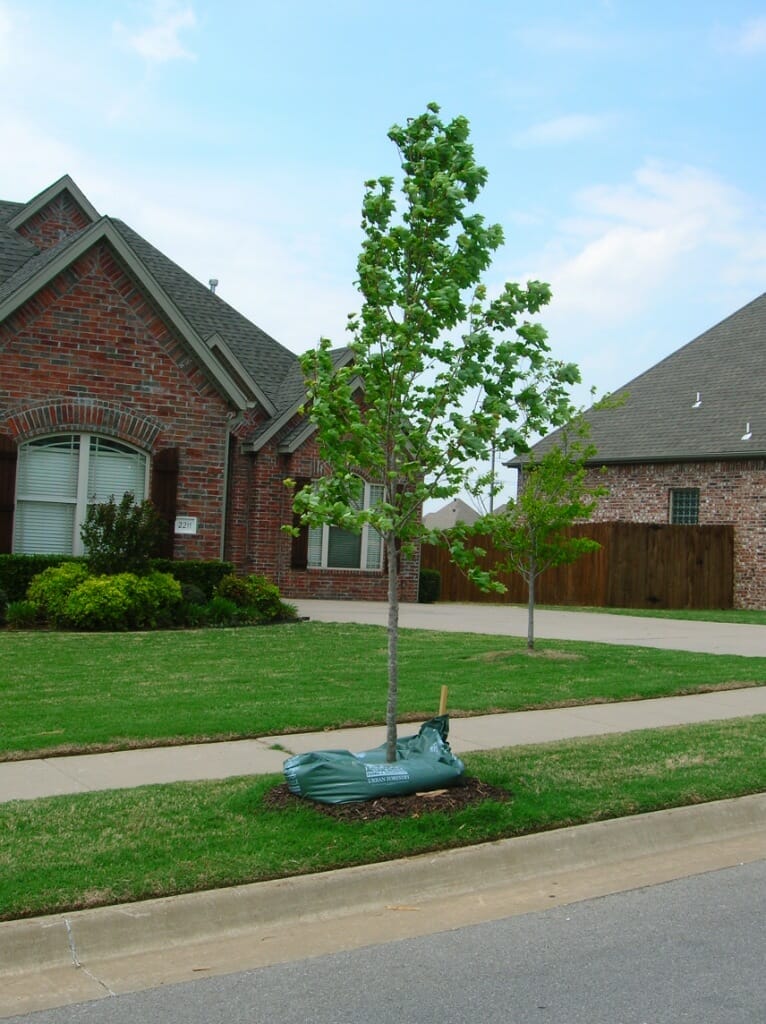 Now that you have a beautiful newly planted tree it is time to master the steps of keeping it that way. The bad news is that for the first 2 years this will take some time and attention on your part, but the good news is that after those 2 years of work your tree should be happy and healthy and not require much more them some pruning and fertilization by your arborist every 3-5 years. Below is a description of each of the subjects regarding your new tree requiring your attention.
Now that you have a beautiful newly planted tree it is time to master the steps of keeping it that way. The bad news is that for the first 2 years this will take some time and attention on your part, but the good news is that after those 2 years of work your tree should be happy and healthy and not require much more them some pruning and fertilization by your arborist every 3-5 years. Below is a description of each of the subjects regarding your new tree requiring your attention.
Water Management
Young trees need adequate water to become established. Although rainfall may be adequate in some areas and in some seasons, additional water may be needed, particularly after planting when root systems are limited. After the initial watering at planting, deciduous trees do not need additional water until the first leaves have reached full size, but then will need water 4-5 times per week and everyday during the plus 90 degree days of summer. We recommend using a water bag or ring (shown in the picture) during the dry seasons for the first 2 years. The water bag will only need to be filled semi weekly or 3 times a week during the hottest part of the summer eliminating the chore of daily watering. After 2 years, most trees can survive with only one or no irrigations, although they would probably do better with monthly applications during the dry season.
Soil Management
It is essential to maintain an area free of turf and weeds around tree trunks, because turf and weeds compete for water and nutrients, and some produce chemicals toxic to other plants. A small turf-free area around a tree also reduces the need for mowers to come close. This clear area must be at least one-foot in radius. Larger areas add little benefit. After four or five years, tree roots are extensive enough that other plants close to their trunks are not a problem, although mower operators should still exercise caution.
A three to four-inch-thick mulch, material placed on the soil surface, controls most weed seedlings. In addition, mulch protects the soil from compaction and erosion, conserves moisture, moderates soil temperatures, provides an all-weather surface for walking, and allows plants to root in the fertile and well-aerated surface soil. The mulch should not be added until 1 month after the tree has been planted so that it does not interfere with the root system obtaining oxygen. Keep mulches at least two inches away from the trunks of trees to minimize disease and rodent damage. A wide range of organic and inorganic materials can be used. If you purchased a watering bag from Urban Forest Pro mulch will be placed for you during the installation of the bag.
Pruning and Training
In years past, severe pruning after planting was thought to be necessary. However, newly planted trees grow quite well if they are pruned lightly or not at all. The key to pruning is to encourage the growth of several large permanent branches, called “scaffold branches,” that will ultimately form the basic structure of the mature tree. If your tree needed pruning directly from the nursery it has already been done by a certified arborist. The young tree will need an initial pruning at 3 years to encourage those structural branches. 2nd to watering your tree this initial pruning is the most important thing you can do for your young tree’s health. Urban Forest Pro provides these prunings at a reduced cost to our planting customers and we will contact you are year 3 to set this up. The pruning also includes a fertilization.
Pest Management
Most trees get off to a good start, but serious problems can be avoided or minimized if the trees are periodically inspected. Inspect trees for the beginnings of insect and disease damage. At the same time, take care of any staking problems, check on tree moisture status, and identify any other problems. The inspection should take only a few minutes per tree, but prompt action on any problems encountered will pay big dividends in healthier, stronger trees.
If your tree was planted by Urban Forest Pro and you think it may have an issue please email pictures to [email protected] or text them to 503-567-1733. We may need a call or an email to let us know you texted the photos as we don’t check that text message line daily.
Looking for large tree planting services near you? Contact our team of ISA-certified arborists who are here to assist you every step of the way.
This post first appeared on https://www.urbanforestprofessionals.com